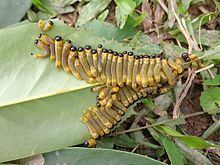Kingdom Animalia Class Insecta Suborder Symphyta Rank Genus | Phylum Arthropoda Order Hymenoptera Family Argidae | |
 | ||
Shizocera is a genus of sawfly in the family Argidae.
Contents
Description
Shizocera sp. (Hymenoptera: Argidae), the Mo sawfly, commonly called ‘Sâu ăn lá Mỡ’ ('Mo-leaf-eating-caterpillar') or 'Sâu Ong' ('bee-like caterpillar') by the local people, has been noticed in pure stands of 'Mo' trees (Manglietia conifera) in northern regions of Vietnam since 1966. The insect (larva) feeds on leaves and is also found in natural forest where the tree is scattered. Because the host tree and its pest have a limited distribution, the literature on the pest has been very limited and mostly confined to the local language.
Mo sawfly was first reported from the results obtained in a study carried out by the Forest Research Institute of Vietnam from 1971–76, in an experimental forest station in Vinh Phuc Province.
Life history
The Mo sawfly deposits eggs under the epidermis of the leaf, in two rows on either side of the midrib. The incubation period depends on the temperature – it may range from 3 days at 28 °C to 26 days at 16 °C. As the eggs develop, they increase in size, as do the eggs of other sawflies, by absorbing water from the leaf. The larvae pass through five instars in the male and six in the female. The larval period ranges from about 17 days at 24 °C to 32 days at 19 °C. The mature larva falls down and creeps into the ground to make a cocoon.
As in other sawflies, three developmental stages are passed within the cocoon – eonymph, pronymph and pupa. The duration of the eonymph stage is short, pronymph stage is 13–15 days and pupa, 8 days at 27 °C to 15 days at 18 °C. The life cycle is completed in 59–65 days at 22–24 °C and 85–86% RH.
The Mo sawfly appears to prefer a temperate climate of 21–24 °C, monthly precipitation of 50–150mm and RH of 85–88%. Under some combinations of climatic factors, the Mo sawfly enters diapause and/or aestivation (see below).
Host distribution
Until recent years, M. conifera was the only known host of this sawfly and its distribution was coincident with that of the host tree (i.e. Vietnam and southern China). The pest has now attacked other species of the genus, especially M. phuthoensis Dandy variety which are also planted as commercial crops.
Population dynamics
In northern Vietnam, emergence of the adult Mo sawfly occurs twice a year – from spring to early summer (March to May) and from autumn to early winter (late August to early January). Emergence during autumn–winter takes place in waves. The favourable period for the growth of the sawfly is about five months during the spring–summer and about three months during the autumn. The insect undergoes aestivation and/or diapause under certain combinations of climatic factors which are not clearly understood.
Diapause occurs in the eonymph stage. Prolonged diapause in cocoons may sometimes continue through the winter, spring and summer, with the adults emerging in autumn–winter of the following year, or the diapause may continue over the summer, autumn and winter, with the adults emerging in the spring of the following year. In the active season, the Mo sawfly may have two generations – one which takes about two months to complete and another which takes about 9–11 months. Depending on the temperature, in some places and some years there may be only one generation per year, due to diapause.
Impact
Although outbreak of the Mo sawfly causes severe damage to leaves, its quantitative impact has not been studied until recently.
According to reports by the local government of Bac Kan province, the infested areas have been rising rapidly from just below 150 hectares to above 1,800 hectares between 2011 and summer of 2014.
Due to abnormally warm temperatures, alarming outbreaks have also been reported by the Plant Protection Sub-Department in Lao Cai province at 6.5 hectares in damages as of late February 2015 with the density of infestation ranging from 150 and up to 600 larvae per branch. So far, manual control efforts have been difficult due to the physical height of the trees and remote geographical locations of the infestation.
Natural enemies
No information is available on natural enemies.
Control
No effective control measures are known. There is some limited success in killing baby larvae directly with broad-use insecticides containing fipronil, fenitrothion, trichlorfon or nereistoxin analogues such as cartap hydrochloride and bensultap. Other combined methods include:
